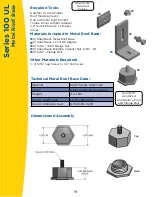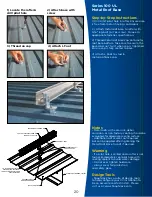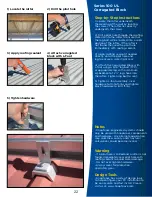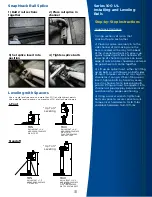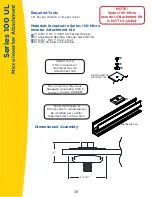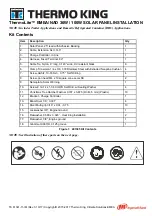
7) Attach rail and
tighten
8) Set SnapNrack tilt tool
26
1) Locate the rafter
3) Prep the base
5) Set post and flashing
2) Drill the pilot hole
4) Attach base
6) Attach standoff clamp
Series 100 UL
10°-45° TIlt Mount
Design Tools
- SnapNrack has a suite of design tools
to help configure your PV installation to
be an accurate and fast install. Please
visit us at: www.SnapNrack.com.
Warning
- If a pilot hole is drilled and a rafter is not
found, immediately seal pilot hole with
roofing sealant to avoid water damage.
- Do not over tighten hardware.
- Always wear fall protection
and safety gear.
Notes
- SnapNrack engineered systems should
only be used with SnapNrack components
and hardware. Any alternate application
may void the warranty and structural
calculations could become invalid.
Step-by-Step Instructions
1) Locate the rafter underneath the
decking of the roof by tapping the
roof surface with a hammer.
2) Drill a pilot hole through the roofing
material into the rafter to ensure that
the lag bolt will be located into a solid
portion of the rafter. If the rafter is
not found then seal the pilot hole
immediately with roofing sealant.
3) Apply roofing sealant to the bottom
of the base and directly onto the pilot
hole to ensure a water tight seal.
4) Attach the standoff base with
a 5/16” lag bolt and a minimum
embedment of 2 ½” lag shank into the
rafter. Tighten Lag bolt to seat.
5) Next attach the standoff to the base
and set the cone flashing by sliding it over
the standoff and directly applying it to the
roof surface. Use all necessary sealants
and attachment methods for flashing.
6) Attach the standoff clamp by sliding
it over the standoff shaft. Adjust it
to the desired height and tighten
Silver hardware to 10-16 ft-lbs and
black hardware to 8-10 ft-lbs.
7) Attach the scrap rail and modules
then tighten Silver hardware to 10-
16 ft-lbs and black hardware to
8-10 ft-lbs. Remove tilt tool.
8) Use the SnapNrack tilt tool to
support the top rail in place (see
page 43 for instructions.)
Summary of Contents for Series 100 UL
Page 48: ...48 Notes...








